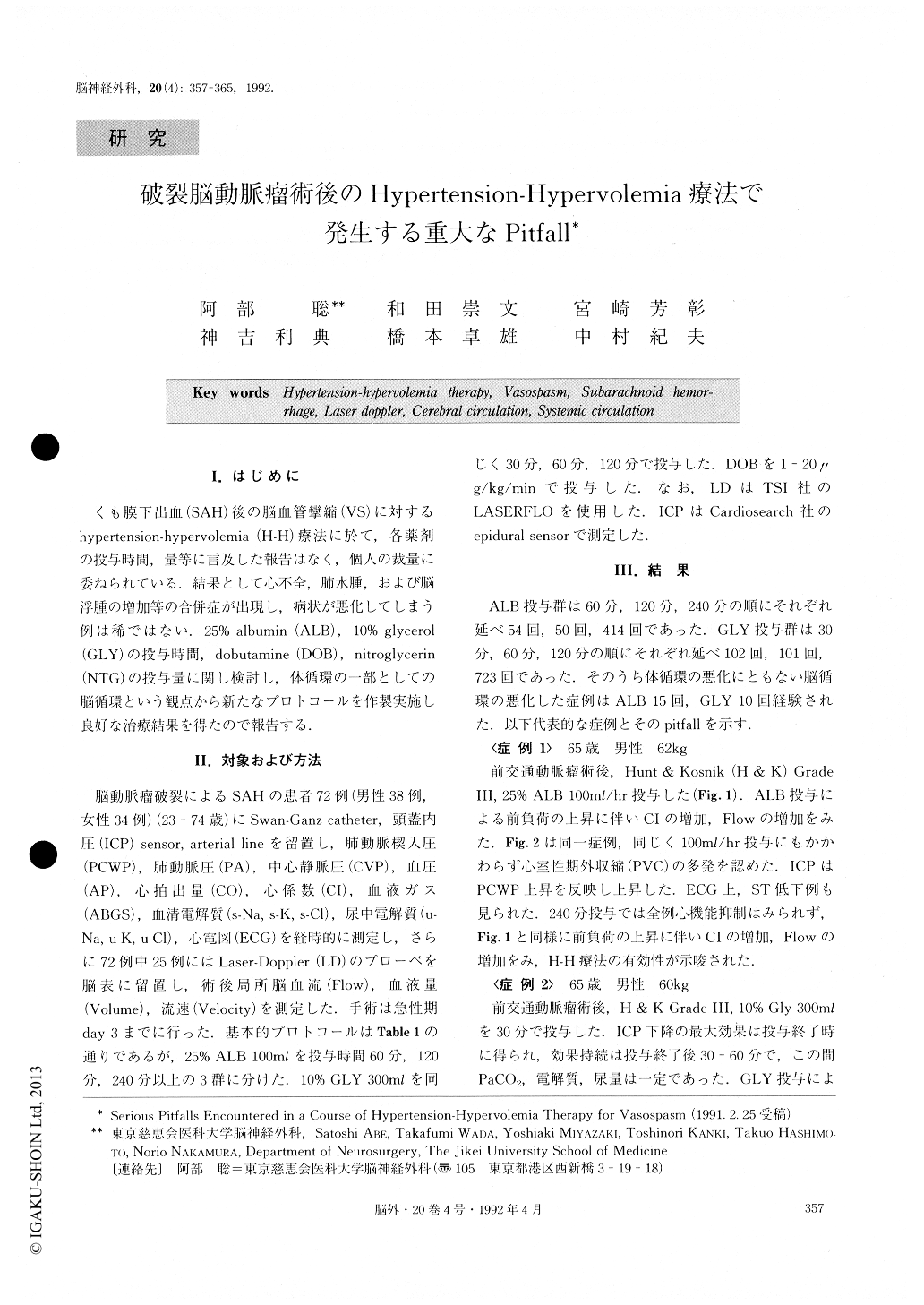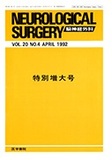Japanese
English
- 有料閲覧
- Abstract 文献概要
- 1ページ目 Look Inside
I.はじめに
くも膜下出血(SAH)後の脳血管攣縮(VS)に対するhypertension-hypervolemia(H-H)療法に於て,各薬剤の投与時間,量等に言及した報告はなく,個人の裁量に委ねられている.結果として心不全,肺水腫,および脳浮腫の増加等の合併症が出現し,病状が悪化してしまう例は稀ではない.25% albumin(ALB),10% glycerol(GLY)の投与時間,dobutamine(DOB),nitroglycerin(NTG)の投与量に関し検討し,体循環の一部としての脳循環という観点から新たなプロトコールを作製実施し良好な治療結果を得たので報告する.
Hypertension-hypervolemia therapy (HHT) is widely employed for treatment against vasospasm after sub-arachnoid hemorrhage (SAH) . A few investigations have been reported to establish the fact that HHT re-sults in a high incidence of congestive heart failure and pulmonary edema as well as deterioration of brain ede-ma. From the point of view that the cerebral circulation is not independent of the systemic circulation, the au-thors investigated the effect of HHT on the systemic circulation of patients with SAH.
In 72 patients, intracranial pressure (ICP), pulmo-nary catheter wedge pressure (PCWP), pulmonary arterial pressure (PA), central venous pressure (CVP), arterial pressure (AP) , cardiac index (CI) , arterial blood gas (ABGS), electrocardiogram (ECG) , serum and urine electrolytes were monitored postoperatively. Furthermore, among these patients, the flow (Flow) , volume (Volume) and velocity (Velocity) of the corti-cal vessels were monitored by means of a Laser Dop-pler in 25 patients. A cisternal or spinal drain was placed in all of the patients.
Elevation of PCWP and CVP and Flow were observed when 300ml of 10% glycerol was administered within a period of 30 minutes, whereas administration of the same dose of glycerol over a period of 60 or 120 minutes caused no significant changes on these para-meters. Elevation of PCWP and CVP and decrease of CI and Flow, occasionally associated with premature ventricular contraction (PVC) , were observed in some patients when 100m1 of 25% albumin was administered. However, administration of the same dose of albumin over a period of 120 or 240 minutes did not cause de-terioration of the cardiac function. These facts could be explained by Guyton's law in which massive transfu-sion causes cardiac dysfunction. Both dobutamine (DOB) and nitroglycerin (NTG) were administered in all patients. Increase of CI caused by 0 - 2Oug/kg/ minute of DOB Or 0-2ug/kg/minute of NTG resulted in the increase of Flow.
DOB increased the cardiac ejection fraction and de-creased the preload. This consequently decreased the afterload. When the preload was sufficient, DOB or NTG increased CI. Simultaneous administration of DOB and NTG gave the patients cardiotonic function without digitalization. Cisternal or spinal drainage is available to maintain the cerebral circulation in good condition independently of the systemic circulation. A patient showed left hemiparesis following the accidental obstruction of the drain. Subsequent to open-ing the drain, he showed apparent improvement of hemiparesis associated with decrease of ICP and in-crease of Flow.
When the cardiac ejection fraction deteriorates or cardiac function curve reaches a plateau, a patient may have decompensation of the cardiac function of subset II or IV of Forrester because of elevated preload by the administration of glycerol or albumine, and on the contrary elevation of ICP and decrease of Flow are often manifested.
The four factors, 1) preload, 2) afterload, 3) cardiac ejection fraction, 4) heart rate, have been advocated for appreciation of the cardiac output. When someone em-ploys HHT while factors 2) and 3) are unchanged, one may be troubled with a number of cardiac problems. We have been treating the patients with cardiac func-tion maintained at the subset I of Forrester (especially 8-12mmHg of PCWP and more than 3.0 of CI) along with maintaining high cardiac output in order to avoid this known pitfall. This clinical protocol for patients with aneurysmal clipping resulted in zero percent of postoperative mortality as well as relatively better func-tional outcome.

Copyright © 1992, Igaku-Shoin Ltd. All rights reserved.


